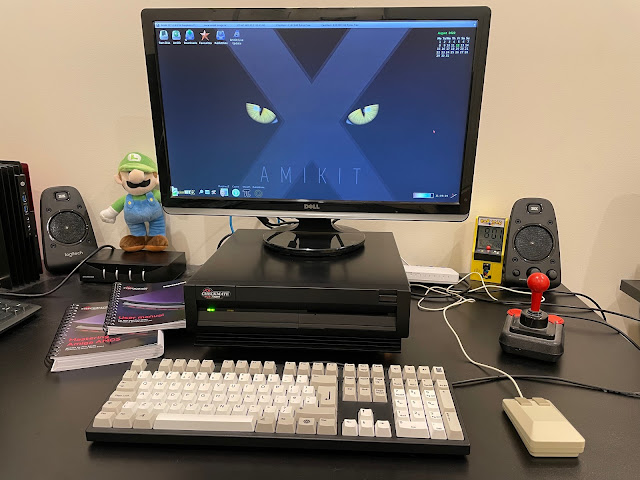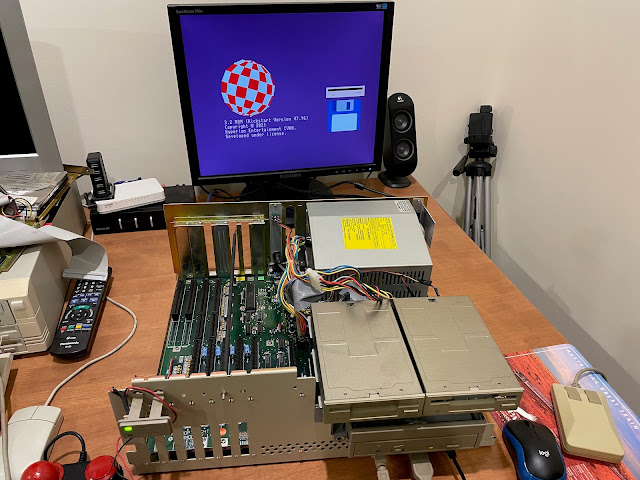Understand the system
Of all of the different techniques this one may be the simplest but also the most important.
When you’re trying to reverse engineer something, understanding the system is key to unraveling the black box which is the PAL. You need to understand what connects to the PAL on the inputs, what it connects to on the output side. Usually going one level back isn’t enough. Why? Because maybe the PAL connects to an OR gate, that then takes a couple other connections. So what you need to do is follow from the primary driver to the consumer of that signal.
Checkmate 1500 Mini case build with Pi4B and Greaseweazle V4
Recently I have been working on another new build project, this time using the recently released Checkmate A1500 Mini case, running a Raspberry Pi 4 with AmiKit XE.

Why simply “dumping” a PAL isn’t always possible?
Rom Dumping
Dumping ROMs is a pretty common practice in the space of reverse engineering, and many eeprom readers are cheap, easily available, and there’s really not much to them. Plunk your ROM chip in the reader, press, go, and you have a binary file with the contents. Provided that your reader supports the ROM chip, or you need an adapter like I built in this post to read Commodore Amiga ROMs in a TL866A:
New Reverse Engineering PALs page
I’ve recently put a new page online on the site. It hosts a basic outline on different techniques to enable one to reverse engineering a PAL, and produce a modern equivalent.
Right now, there are about a dozen topics/techniques, with no content beyond basic background information.
As time goes on, I’m going to add more and more posts, with the page serving as the outline, index, with centralized links.
Building the AA3000+ Part3 (Daughterboard)
Ok time to to the DB for the AA3000+
This is more or less “one stage”
First as usual: a board with all passives on:
I made a Locator for this instead of Hese file:
https://locator.reamiga.info/locator.php?project=AA3000PlusDB
My PAL stimulator
If you’ve been following my blog, you’ll see that I’ve been reversing a Commodore Amiga SCSI HDD Expansion card called the Dataflyer. On that Dataflyer, there’s a PAL that handles address configuration (the latch), chip selects, and converting the 68000 signals to those the peripherals understand.
Commodore Amiga AutoConfig expansion card process
Since I’ve been reverse engineering a DataFlyer Plus HDD SCSI expansion card for the Commodore Amiga, I’ve needed to get a much better understanding of how the AutoConfig process works. I’m by far no expert on it, but I have learned a lot and wanted to share a couple logic analyzer traces of this occurring in the wild. The Commodore documentation refers to these expansion cards as PICs or Plug-in Cards.
August 12, 2022 - Amiwest 2022 updates
Amiwest 2022 show updates: The reserverations page has been updated with details on the hotel, book now and save! The exhibit page has been updated with a new exhibitor for Amiwest 2022.
AmigaOS 4.1: Enhancer Software 2.2 Released!
Hi everyone, Version 2.2 of Enhancer Software from A-Eon Technology was released today! Please read on for the full press release as posted on Amigaworld.net: 9th August 2022A-EON Technology Ltd is pleased to celebrate six years of the Enhancer Software. by releasing version 2.2 The new update is available to all existing Version 2 users as […]
Amiga 2000 Rebuild Project Part 2
Today I am continuing my rebuild of my owned from new Amiga 2000. I have done a lot of work already in Part 1 if you want to read up first, as I am continuing from where Part 1 ends.
June 29, 2022 - AmiWest 2022 Banquet To Feature Tim Jenison!
Tim Jenison, founder of NewTek, to be the featured presentor at Amiwest 2022 banquet. This will be Mr. Jenison's first appearance at an Amiwest show. We are opening up banquet ticket reservations and recommend anyone interested in attending to reserver their ticket today. Space will be limited!
July 24, 2022 - Amiwest 2022 progress report
In honor of the 25th incarnation of Amiwest, the organizing team has been hard at work putting together an amazing show. Click read more to learn about the latest happenings at Amiwest and take our 2022 attendee survey.
Amiga 2000 Rebuild Project Part 1
This month has been crazy busy for work, so I have not had as much time to work on my Amiga projects as I wanted. That said, I made some big progress this month on the rebuild of my Amiga 2000.

Mutant Monty - Amiga Remake
Want to see what is happening to this project "Mutant Monty" - remake / port for the Amiga